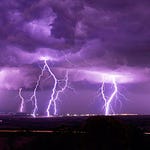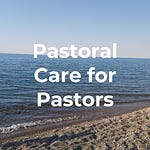It may sound too familiar to say that we connect with God through prayer. That statement may be something we know but not something we experience. We give mental assent to it as a true statement even while yearning and longing for a deeper experience of relationship with God.
My journey of prayer has seen many peaks and valleys. Like in this image, I often find myself descending into a valley while looking ahead to the next peak.
In this article, I want to share four phases I've gone through in my journey of learning how to connect with God in prayer. My hope is that you will find value in my experience for growing in your own practice of prayer.
First Phase: God as the Cosmic Santa Claus
I grew up "going to church." I imagine you could say I was "born and raised" in the church. Yet my concept of prayer was very anemic. Sure, we prayed at church, but it was the "opening" and "closing" types of prayer, along with a blessing offered before we shared the Lord's Supper together. And we prayed at home, though it was mainly a blessing before we ate or my father praying with my brother and me before we went to bed.
I knew that I ought to pray. And I knew that I ought to include praise and thanksgiving. But other than thanking God for the day and for anything good that had happened to me that day, I did not have a robust way of praising and worshiping God in prayer.
This was shaped by my view of God at the time -- a very weak, limited view that saw God as the Cosmic Santa Claus. He saw everything, he knew if I was awake, and he definitely knew if I was bad or good. As an adolescent, and then a teenager, I was fully aware that there was enough "bad" to warrant the Cosmic Santa Claus to not send "gifts."
So my prayers were mainly of the "Forgive me for X, forgive me for Y" variety. I would do this in bed at night before I went to sleep. Many nights I would fall asleep scanning my mind for any unconfessed sin because I was fearful of missing some sin that I had overlooked. What would God think? After all, he was already aware of any sin that had been committed; how could I not be?
In summary, I found this phase of prayer fearful, even while it cultivated an awareness of God.
Second Phase: Finding Other Prayer Exercises
I must have known that there was more to prayer than what I was experiencing because I kept with it and I kept exploring it, especially in my junior and senior years of high school.
At my local Christian bookstore, I'd hunt for books about prayer. I found expositional teachings about prayer, prayer devotionals, and Charismatic books about prayer that I had no capacity to understand at the time. But most importantly, I found tools I could use to help me pray.
I ran across the A.C.T.S. acronym (Adoration, Confession, Thanksgiving, Supplication). This was helpful because it gave me a framework. I realized that I could break up my prayer time into different areas. I still struggled with adoration but found my groove in confession. Thanksgiving could be tough, and I began to learn that this "toughness" came out of a skewed sense of prayer -- my belief that prayer was about asking God for things.
During this phase of prayer, I began to learn that prayer was not only about asking God for things, but also thanking God for things. But prayer was still transactional -- it was about making the exchange of thanksgiving and confession, the credits and debits, between God and myself.
Third Phase: Liturgical Prayer and Psalms
In college, I was exposed to a wide experience of Christian traditions. This was more helpful to me than I recognized at the time, and I learned without knowing it from many others.
I was particularly intrigued with the vibrancy that many of my new friends prayed with. It was a vibrancy I was lacking. I knew something was missing in my relationship with God but I didn't know what.
I took an upper division-level class on Christian ministry with a professor who became very influential for me. He introduced us to the Christian classics of spirituality. We were also required to keep a reflections journal where we interacted with our readings. This was what I had been missing! A way of interacting with God that went beyond a transactional give-and-take!
I was introduced to lectio divina, the ancient way of reading the Bible that leads to meditation and prayer. I learned about the form of praying called contemplation. I began to read Thomas Merton, Henri Nouwen, and Eugene Peterson.
I began to see that prayer was at least as much about being with God as it was talking to God.
Eventually, I ran across liturgical prayer and the Book of Common Prayer. At the time, this was the missing link for me -- a way of praying through brief collects, longer canticles, and prayers of confession. And there was even space to read through the Bible in a three-year cycle!
I latched onto this form of "morning and evening prayer" and tried a variety of different forms. The value in learning to pray in this way is that I began to see that by slowly reading through and praying the prayers, even meditating on them, I was clearing out the "busy-ness" of my mind and creating space to simply be with God.
I eventually simplified this form to praying the Psalms. I began to pray through Psalms each month, all 150 of them. I used the psalms as my prayer book, reading, reflecting, and meditating on them in a monthly cycle that taught me the rhythm of giving thanks to God, praising him, lamenting, and finding refuge in him.
Fourth Phase: Learning to Lead Others in Prayer
I've never felt proficient in prayer, but I reached a point where I was satisfied with the way I was stumbling through it. I had fallen into a rhythm of praying the psalms daily, meditating on the Bible, being with God, and making intercession for others.
A good friend of mine then invited me to a Day of Renewal put on by Strategic Renewal and Daniel Henderson at the Chicago Tabernacle. I went to this, along with a good friend from my church, and was absolutely blown away.
At this event, we learned a way of prayer that emerged directly from the Bible. Daniel called it the 4/4 pattern of prayer and summarized it as "scripture-fed, Spirit-led, worship-based prayer." He taught us to read a passage from the Bible, take note of the praiseworthy characteristics and attributes of God, and then pray these back to God in the areas of Reverence, Response, Requests, and Readiness.
The “4 R’s” took their cues directly from the Bible. If God was described in the Bible as a Rock, then we praised him for being our Rock in a difficult time; we asked him to help us look to him as our Rock in times when we would need him; we petitioned him on behalf of others, that they would find him to be their Rock in times of trouble; and we asked him to help us walk by faith in that truth as we ministered to others.
This was life-giving for me. I had learned that prayer was about being with God, but now I could use the words of God to speak back to God. The Bible itself was my prayer manual. If I didn't know what to pray for, I could simply read a portion of the Bible and be overwhelmed with reasons to praise God, or with specific, biblical petitions to pray on behalf of others.
But most of all, in this phase, I was inspired to teach prayer to others. I began to pray more regularly with a network of pastors who prayed together and led their churches in biblical prayer. I began to build more prayer into the men's mentoring group I was leading. I created a monthly prayer meeting at my church.
Through these four phases, I learned how to be aware of God (phase one), to be more thankful for what God has done (phase two), to simply be with God (phase three), and to teach others these ways of prayer (phase four).
Perhaps you've seen yourself in this story. Prayer is both a mystery and a communion with God with great power.
What most stuck out to you from reading about my experience? How do you yearn to grow in prayer? How can you more effectively lead others in prayer? How might I be able to help you in one or more of these areas?
As always, let me know how I can serve you in this.
Love First,
Jeremy
If you enjoyed this issue, please “like it” by clicking the heart below and share it with two friends or colleagues. Thank you for your support!
If you’d like to connect further, here are some ways we can do so:
Let’s schedule a 15 minute call just to get to know each other. Schedule a time here and let’s connect!
Let’s connect over a powerful coaching session where we can explore your questions and challenges and find clarity and purpose. This special session can be scheduled here at my newsletter-subscriber rate of $100 for 60 minutes.
Read either of my books on pastoral and church health and drop me a note with any thoughts or questions.
Listen to my podcast, Discipleship Conversations and let me know what you think!














